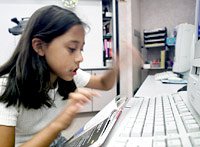Keys to the (Online) Kingdom: The Importance of Basic Computer Skills
It may seem obvious, but one of the things I need to cover at my technology-training workshops is the basic what, why, and how of keyboarding. Without the basic ability to type quickly and accurately, getting your ideas and data into a computer can take a lot of time and can be frustrating. Who really wants to use the hunt-and-peck method of inputting data for the rest of their lives?

Sure, someday we may have foolproof voice-recognition software, which will eliminate the need for typing, but it's not readily available today. So, to use a computer with ease, being able to type is still an important skill. Once students learn to keyboard and learn basic word processing skills, the integration of the computer into all disciplines is much easier.
Technology skills outlined in the No Teacher Left Behind Act require that students be technology literate by the end of the eighth grade. Expectations are that students create reports on a word processor, use a spreadsheet for calculations, and use a presentation tool for demonstrating new knowledge. However, many students have never been taught the basics and continue to use the computer as if it were a typewriter.
Keyboarding should be taught in the early grades -- before students acquire bad habits. Free typing programs can be found on the Internet, and software packages can be purchased. The tried-and-true teacher-taught method -- the method by which most of us learned to keyboard -- is one way to ensure students learn to correctly input data.
While students are learning to keyboard, other basic skills can be taught, such as
- use of a mouse (click, double-click, left click, right/control click, click and drag)
- opening a new document.
- saving a document (proper naming and location for saving).
- standard fonts, such as Times New Roman, Arial, Georgia, Comic Sans.
- appropriate size of font for print and presentations.
- one space after all punctuation, including periods.
- alignment (left, center, right).
- printing.
- closing a document and an application.
As students become comfortable with these basics, other skills can be taught. Many skills can be incrementally learned in the third and fourth grades. The left and right margins in Microsoft Word by default are unusually wide; therefore, students should be taught to change the margins (and even reset the default, if desired).
Another underused function of the computer is the setting of tabs. To get from one place to another place on a page, many times students will consecutively press the space bar or the preset tab. Because the typewriter had only one kind of tab, the different kinds of tabs on a computer (left, right, center, decimal) are little known. Students must be given examples of when each of these tabs are used, such as
- left tab: indentation of a paragraph.
- Center tab: in headers/footers and certain kinds of poetry.
- right tab: in headers/footers and to place the name, date at top of paper.
The proper use of font styles are also important. For example, underlining on a computer is discouraged because the underline token breaks a font descender (for example, the word young). The bold style is more commonly used for headings. The italics style, not the underline, is used to denote book titles and the like.
Once a student has learned to click and drag the mouse, the commands to copy, cut, and paste, as well as the use of the delete (and backspace) keys, can be taught. Other useful skills include, but are not limited to,
- undo and redo typing.
- bullets and numbering.
- headers and footers, including page numbering.
- tables.
Other word processing skills, such as columns, breaks, sections, borders, and word count, can be taught in middle school.
Read another post of mine, which answers many of your questions and gives links to free resources on keyboarding and word processing skills.